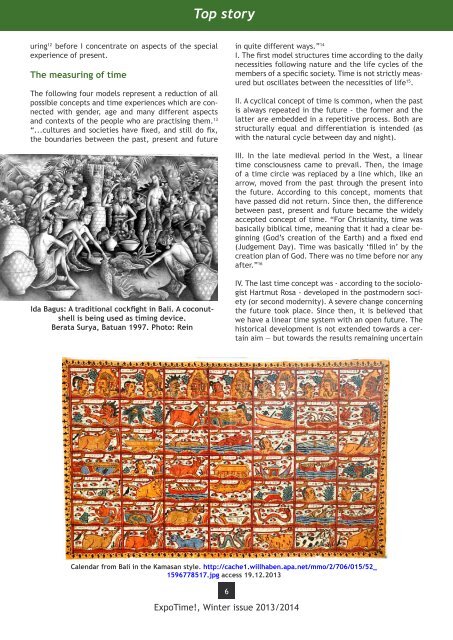Rein-2013-Contemporary-issues-in-museums
Rein-2013-Contemporary-issues-in-museums
Rein-2013-Contemporary-issues-in-museums
You also want an ePaper? Increase the reach of your titles
YUMPU automatically turns print PDFs into web optimized ePapers that Google loves.
Top story<br />
ur<strong>in</strong>g 12 before I concentrate on aspects of the special<br />
experience of present.<br />
The measur<strong>in</strong>g of time<br />
The follow<strong>in</strong>g four models represent a reduction of all<br />
possible concepts and time experiences which are connected<br />
with gender, age and many different aspects<br />
and contexts of the people who are practis<strong>in</strong>g them. 13<br />
“...cultures and societies have fixed, and still do fix,<br />
the boundaries between the past, present and future<br />
<strong>in</strong> quite different ways.” 14<br />
I. The first model structures time accord<strong>in</strong>g to the daily<br />
necessities follow<strong>in</strong>g nature and the life cycles of the<br />
members of a specific society. Time is not strictly measured<br />
but oscillates between the necessities of life 15 .<br />
II. A cyclical concept of time is common, when the past<br />
is always repeated <strong>in</strong> the future - the former and the<br />
latter are embedded <strong>in</strong> a repetitive process. Both are<br />
structurally equal and differentiation is <strong>in</strong>tended (as<br />
with the natural cycle between day and night).<br />
III. In the late medieval period <strong>in</strong> the West, a l<strong>in</strong>ear<br />
time consciousness came to prevail. Then, the image<br />
of a time circle was replaced by a l<strong>in</strong>e which, like an<br />
arrow, moved from the past through the present <strong>in</strong>to<br />
the future. Accord<strong>in</strong>g to this concept, moments that<br />
have passed did not return. S<strong>in</strong>ce then, the difference<br />
between past, present and future became the widely<br />
accepted concept of time. “For Christianity, time was<br />
basically biblical time, mean<strong>in</strong>g that it had a clear beg<strong>in</strong>n<strong>in</strong>g<br />
(God’s creation of the Earth) and a fixed end<br />
(Judgement Day). Time was basically ‘filled <strong>in</strong>’ by the<br />
creation plan of God. There was no time before nor any<br />
after.” 16<br />
Ida Bagus: A traditional cockfight <strong>in</strong> Bali. A coconutshell<br />
is be<strong>in</strong>g used as tim<strong>in</strong>g device.<br />
Berata Surya, Batuan 1997. Photo: <strong>Re<strong>in</strong></strong><br />
IV. The last time concept was - accord<strong>in</strong>g to the sociologist<br />
Hartmut Rosa - developed <strong>in</strong> the postmodern society<br />
(or second modernity). A severe change concern<strong>in</strong>g<br />
the future took place. S<strong>in</strong>ce then, it is believed that<br />
we have a l<strong>in</strong>ear time system with an open future. The<br />
historical development is not extended towards a certa<strong>in</strong><br />
aim — but towards the results rema<strong>in</strong><strong>in</strong>g uncerta<strong>in</strong><br />
Calendar from Bali <strong>in</strong> the Kamasan style. http://cache1.willhaben.apa.net/mmo/2/706/015/52_<br />
1596778517.jpg access 19.12.<strong>2013</strong><br />
6<br />
ExpoTime!, W<strong>in</strong>ter issue <strong>2013</strong>/2014


